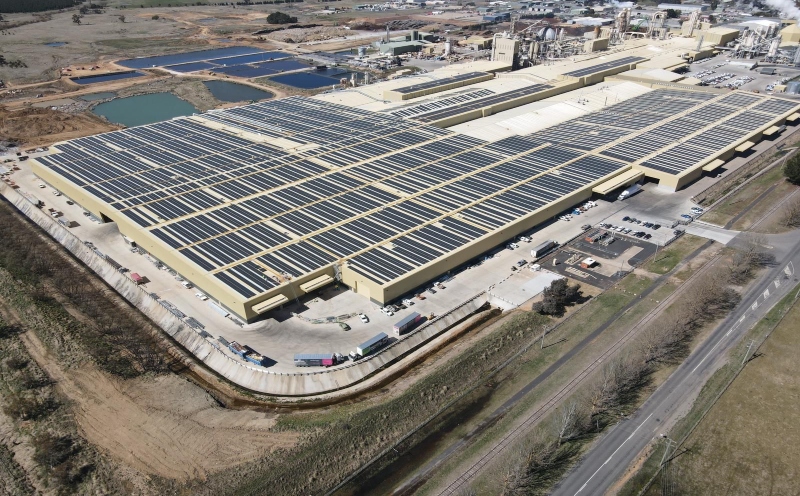Australia’s largest roof-mounted solar PV system – featuring an incredible 27,000 panels spread across almost 8 hectares of rooftop – is nearing completion with the massive 10 MWdc system set to commence operation this week.

The 10 MWdc rooftop solar system, spread across the roof of Australian Panel Products’ (APP) manufacturing facility in the New South Wales (NSW) Central West, is set to come online this week with Newcastle-based engineering, procurement and construction (EPC) provider earthconnect confirming it is in the final stages of commissioning what will be Australia’s largest roof-mounted solar PV system.
“We’ll be 100% operational by the Christmas break,” earthconnect’s Mitchell Stephens told pv magazine Australia. “We’re in the final phases of commissioning, and completing our final quality checks this week, to make sure everything is working exactly as it should be before it will be fully energised.”
Earthconnect said once the system has been commissioned, and the communication has been established and proven, it will be energising the system, and in turn entering revenue service.
The 10 MWdc system, which has been rolled out in two stages, has been installed atop the roof of Australian-owned manufacturer APP’s enormous particleboard production facility in Oberon, about 180 kilometres west of Sydney.
Stage one of the project, which was installed some two years ago, delivered a 2 MWdc solar system while the latest stage has boosted that generation capacity to 10 MWdc.
The extension comprises 21,000 385 W modules spread across approximately 45 kilometres of mounting rail, coupled with 53 110,000 TL inverters. The new install combines with the 6,000 solar modules and 28 50,000 TL inverters that formed the original system.

“The amount of roof we’ve covered with panels is nearly 7.8 hectares … it’s enormous,” Stephens said. “It’s pretty impressive to stand up there on the roof and look at it.”
The massive rooftop solar PV system is expected to generate 14 GWh of clean energy each year, helping reduce carbon emissions by an estimated 14,980 tonnes annually.
Stephens said the rooftop solar system shapes as a triumph for APP, providing clean energy and maximising the site’s attributes.
“There’s not many facilities as large as this in Australia so it’s definitely a win-win,” he said. “The client is saving a lot of money on energy using what would otherwise useless space to generate a lot of clean energy.”
The Oberon system adds to APP’s already impressive rooftop solar portfolio, which includes a 1.3 MW solar installation at its Charmhaven manufacturing facility and a combined 2.1 MW of solar energy generation at its Somersby plant.
APP, which incorporates the polytec and Structaflor brands, is continuing to build its renewable energy generation with earthconnect to install another 2.5 MW of roof-mount projects in the first half of 2022, providing the manufacturer with a combined rooftop solar PV portfolio of approximately 16.3 MWdc of solar production.
Earthconnect has labelled the APP system the largest rooftop system in Australia, and it is certainly impressive at more than three times the size of the 3 MW solar panel installation on the rooftop of Moorebank Logistics Park in Sydney and it dwarfs the 1.2 MW of solar being installed atop Ikea Adelaide’s expansive rooftop on its store adjacent to Adelaide Airport, in South Australia.
But the ongoing rollout of rooftop solar means it is likely to be soon overshadowed with Green energy fund CEP.Energy earlier this year unveiling plans to build a 24 MW rooftop solar farm and a grid-scale battery with capacity of up to 150 MW on the site of the former Holden car manufacturing plant at Elizabeth in South Australia.

The APP system is the largest individual project delivered by earthconnect, which has a portfolio of more than 44 MW of solar installs, including the 5 MW Lovedale Solar Farm near Cessnock in the NSW Hunter Valley region, an estimated 14 MW of commercial PV projects and more than 17 MW of residential installations.
Earthconnect said the project is on time and on budget despite the disruptions caused by the Covid-19 pandemic, inclement weather and interruptions to the supply chain.
“The biggest challenge for use has been the pandemic,” Stephens said, revealing that the lockdowns had made coordinating staff difficult while workers had to endure freezing conditions during winter.
The well-documented issues around module supply also impacted the project but Stephens said it had just required “a bit of shuffling around and reoganising”.
“In terms of that, we did get through the project without any significant delays in delivery just because of the massive scale,” he said.
Post time: Dec-24-2021